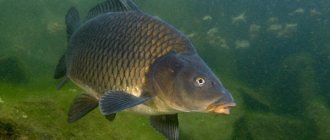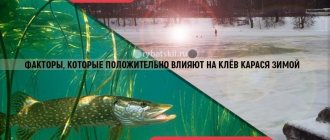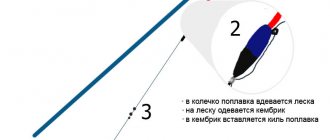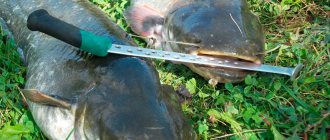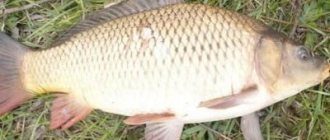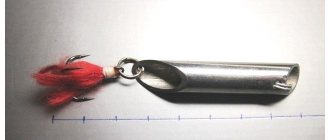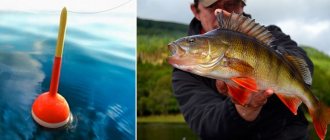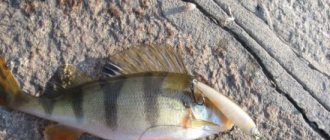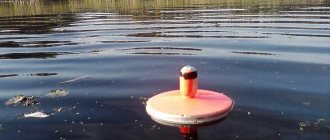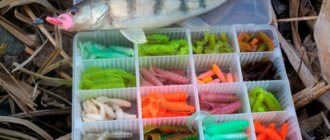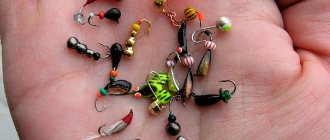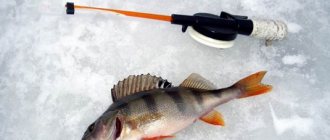Perch is not a very neat or cautious fish; ordinary float gear is sufficient to catch it. This predator can also be caught well with a spinning rod, but both methods help in catching only small and medium-sized specimens, and also turn out to be ineffective when fishing in windy currents. During cold periods of the year, during rain and wind, the listed gear is not very effective. To get better results, use a perch donk, which more often allows you to catch trophy specimens, allows you to fish in the current, and make long casts from the shore.
Features of catching perch on a donk
Content
Perch is often caught using live bait due to its versatility. Donka fishing has its own characteristics in comparison with other methods of hunting. Only taking into account the peculiarities of tactics, the characteristics of the reservoir, and the method of fishing, is it possible to get the desired trophy.
Perch is a predator and tends to attack various live baits. Small fish with bright scales or leeches should attract the perch and provoke a sharp attack from the float. It is better to catch live bait in the selected reservoir; small roach, gudgeon and bleak are suitable for this role. To extend the life of live bait, you should thread it with a hook through the nostril and bring the point out through the lower lip.
There are many types of bottom tackle, but experienced fishermen often call the jig the best. The selection of jigs is carried out individually, but in conditions of good visibility in the water it is better to use dim varieties of jigs, and in opaque water shiny, bright specimens perform well.
Any bottom fishing rod, the hooks of which are equipped with animal baits, can be considered set for catching perch
It is important to consider the following features when fishing for perch:
- Donk fishing is often done from a boat; the key difference from shore fishing is the need to use a rod about 0.5 m long. It is even better to install an inertial reel instead of a spinning reel;
- It is not necessary to use live bait and bait; pieces of fresh fish and crayfish are allowed;
- It is worth remembering that fishing with live bait requires lengthening the leash. A carabiner and a leash made of fishing line with a diameter of 0.25 mm are attached to the main line at a distance of 40 cm from the sinker;
- Bottom fishing is effective in water depths of 3 m or more;
- large perch are more willing to attack moving baits. We recommend animating the bait by moving the tip of the fishing rod. The game of bait can greatly increase the attractiveness of the bait.
Read more
What is a microjig spinning rod and what are the differences?
Installation of a fishing rod for perch fishing
To catch perch, a fly rod or Bolognese rod with a length of 4 to 6 meters and a weight of 5 to 20 grams is used. If the perch stays near the shore, then it is better to fish with a swing, since such a rod can be used to attach the finest equipment: a fishing line with a diameter of 0.12 mm and a float with a carrying capacity of up to 1 gram. The reel and rings on the lap dog will quickly render such a thin fishing line unusable.
If fishing is carried out in a fast current, then it is better to use a 5-meter lapdog with a spinning reel. The size of the spool on the reel is from 1000 to 2000. The diameter of the fishing line is from 0.16 to 0.2 mm. The float is installed with two attachment points.
It is loaded with one pellet and a subplot with several more pellets.
When fishing with thin tackle there is no particular need for a leash. If the bottom is clean and there are no snags, then the leash is not installed. The fact is that he can twist the line if it is soft. This increases the likelihood of overlaps and deformations of the main line. In addition, using a leash involves using a thicker fishing line. If you have to fish with a leash, then its thickness does not exceed 0.1 mm and length 15 cm.
The hook for catching perch on a fishing rod is No. 18-20 according to the international classification. If fishing is done with bloodworms, then hooks with the thinnest wire, special “bloodworm” hooks, are used. If you fish with a worm, then use hooks with a long shank with small notches for better fixation of the bait. It is important to have a sharpener for straightening hooks that have become dull on the rocky bottom. Some anglers claim that perches bite better on hooks of bronze and golden shades.
Tackle for catching perch on donka
We will need simple bottom tackle; now there is no need for complex equipment:
- The main line is taken with a cross-section of 0.2-0.3 mm. We select the length taking into account the fishing method and the remoteness of the promising location;
- hooks Numbers 4-8 are most often attached to the leash. If there are a lot of useless bites - there are either cautious or small fish, it is better to use smaller hook options - No. 12. Half a worm is used as bait;
- sinker. They are installed on a separate leash, the weight is selected so that the tackle stays well in one place. The length of the leash is taken to be small - 20-40 cm;
- rod It is better to take one with a flexible tip, which allows you to detect small bites.
If during float fishing a worm is actively used as a bait, then it is better to use larger baits on the bottom, ideally a gudgeon, but any small fish will do. Catching perch on a bottom with live bait often brings large and medium-sized specimens, since small specimens hunt exclusively for fry.
Purposefully catching perch on a donk makes sense in cases where you can hope for bites from large representatives of these fish
How to make donka
I'll start by telling you how to make donka at home, rather than buying it in stores.
Donka is perhaps one of the most popular fishing gear. Therefore, to begin with, I decided to talk about the simplest version of donkey. A simple donka does not mean at all that few people can be caught with it; a lot can be caught with such tackle. Therefore, remember, pack and go fishing.
What is needed for donka
To do this, we will need a main fishing line 0.4 mm thick, also a fishing line for leashes 0.2-0.3 mm, 5 carp hooks, an olive sinker of 50-70 grams, one fishing carabiner.
How to assemble a donk
So, let's start assembling a simple donkey. To begin, we will tie leashes from fishing line 7-10 cm long to the hooks. All leashes must be tied to the hooks with a Figure Eight knot. Next, we take the main fishing line and tie an “olive” weight to it at the end, also using a figure eight knot. We retreat along the fishing line 30-35cm and knit the first leash with a hook. We retreat another 10cm along the line and tie the next hook. And so does everyone else. After all the hooks are tied, we retreat another 15 cm and tie our carabiner with the same knot. It looks something like this:
All! Donka is ready! We fasten it with a carabiner to the fishing line on the fishing rod, it can be on a reel or a slingshot, it doesn’t matter, you can even tie it to a tree. You attach the bait, cast and catch.
Time and place for catching perch on a donk
Perch tend to lead a school life, so when you get a bite in one area, it makes sense to re-cast the gear. Usually there are 10-15 individuals in one flock. The striped predator mainly goes for bait; the right mixture will ensure successful fishing, but it does not have any special preferences when it comes to places.
It is easiest to find fish during the summer fishing season, as they reveal their location by splashes on the water that appear during the hunt. It is easy to identify a promising area by the formation of a cauldron of fry - in the center there is a predator. The predator tends to make characteristic sounds that are not characteristic of any other underwater inhabitant. In summer, the fish stay in shallow water, close to vegetation or riffles, as there is a lot of prey here.
When planning the time period and place for fishing, you should consider:
- small individuals always stay close to the shore, first near plants (in summer), and in autumn they prefer open areas. Large ones live in the depths, leaving it only during feeding;
- in still water, the perch stands near deep-growing plants near clean areas of water, as well as in areas with weak currents near shelters;
- the predator is caught throughout the day, and the only exception is at night;
- The best chance of catching fish comes on a cool, clear day in the early morning or around sunset. These periods are the predator's hunting time.
Read more
How to make a donk with your own hands correctly: their types, production and installation
In the warm season, the same fishing rules apply, but in winter the bite changes.
Winter fishing begins 10-20 days after freeze-up. The predator also gathers in flocks of 5-7 individuals, spreading throughout the entire reservoir in search of deep holes. It is advisable to fish in winter in calm weather without strong temperature fluctuations. It is better to fish at temperatures from -10 ° C to -20 ° C during the day or evening.
Striped predators spend a significant part of their time in the lower layer of water
Medium class spinning rod for perch
When catching trophy specimens weighing over 1 kg. It is better to use a medium class spinning rod. The test weight of such rods ranges from 15 to 40 grams. They are distinguished by their slow action and long range. Their length varies between 2.7 - 3 meters. These fishing rods are used to fish on wide rivers in areas with depths of more than 3 meters.
Since fishing is carried out at depth, often in the bottom layer, wobblers, twisters and spoons loaded with weights are used. The wiring is average and slow.
The rings on these rods are larger. The reel on mediums is used from 2500 to 3500. A wattle with a diameter of 0.18 or a fishing line with a diameter of 0.25 mm is wound on it.
Donkey bait for perch
Not many baits can be combined with donka:
- perch on the bottom using live bait is the most promising equipment;
- worms (dung, earthworms);
- chopped pieces of fish.
When choosing live bait or cutting fish for bait, you should choose the right size. Excessively large live bait will be unattractive to perch, because the size of the predator is not always large. Most often they are caught with perch, gudgeon, bleak, small gobies and pieces of carp or crucian carp. Live baitfish perform better. It is important to lengthen the leash; this will allow the fish not to feel the tension of the line when testing the bait.
The variety of baits for catching perch is relatively small
Donka for perch - suitable gear and fishing features
Perch is most often caught either with a spinning rod or using float gear. But there are often situations when fishing when neither one nor the other method works. Float fishing for perch can be hampered by strong winds, or the location of the fish - long distances, as well as strong currents make fishing with float tackle impossible. With spinning the situation is a little different. In some reservoirs, perch flatly refuses to take artificial baits, but reacts well to a worm or live bait. In such situations, catching perch on a donk helps out, because such gear allows you to fish at a great distance from the shore, in strong winds, and in strong currents. Such fishing also implies the possibility of using bait, which can significantly increase the catch, however, it should be borne in mind that the composition of the mixtures differs from the options used for catching peaceful fish.
Feeding methods
The need to feed predators always causes controversy; some use bait, while others immediately abandon the gear. If you decide to feed the perch, then crushed worms, bloodworms or maggots are added to the mixture. Additional ingredients depend on the bait delivery method. You can cast to nearby areas by hand, but first make balls of soil, clay and protein bait. If you don’t want to throw bait, use a slingshot.
There is another method of fishing, which differs in the type of bait. Some professionals use a dusty mixture that attracts peaceful fish. A predator will inevitably come to the accumulation of prey.
To feed a distant point, feeders are used; their design is created specifically for delivering animal components, most often maggots, to the fishing site. The case contains small holes and a cover. The bait is placed through the removable lid, and through small pores it gradually dissolves. Live worms are placed in such a mixture, which gradually emerge from the lump and attract a predator for a long time.
Techniques and tactics of catching perch using bottom tackle
The primary task when catching perch on a bottom from the shore is the correct choice of fishing spot. Casting should be done on edges, exits from holes and places on the bottom where there are a lot of shells. The listed places are important because they do not allow the current to erode the bait along the entire bottom and inhibit the spread of the bait.
Read more
How to catch pike with live bait in the summer?
First of all, you need to decide on the fishing point
To understand the type and topography of the bottom, use a special sinker or feeder (without leashes with hooks). The fisherman pulls the load along the bottom, listening to the change in tension. After finding the place, they feed it and throw in the tackle.
Important! You should not make regular recasts, as the sound of a falling feeder causes concern even in timid fish, and it also shortens the lifespan of live bait.
If the bite is bad, it is better to add chopped worms to the hook and bait mixture, which emit a strong odor that attracts predators. The smell of worms can attract perches at a distance of up to 20-50 m. Another way to revive bites is to drag the feeder along the bottom at a slow pace, but here a sliding sinker works better, increasing the sensitivity of the gear.
Perch on a bottom fishing rod
BOTTOM FISHING FISHINGS In June, when fishing in rivers with currents, a bottom fishing rod is effective. What is she like? First of all, a fairly rigid spinning rod, 2-2.5 m long, an inertial reel with a large winding diameter, with a set of weights, depending on the strength of the current, and steel holders for leashes. As for the sinkers, it is clear that in strong currents you need heavy, flat sinkers that would keep the bait from drifting away. The diameter of the fishing line must be at least 0.4 mm. We also need signaling devices that can be easily and simply attached to a spinning rod. During the fishing process, it is enough to have two or three equipped spinning rods. A larger number of them with a good bite creates nothing but inconvenience. As mentioned above, the best places for fishing are as follows: in pools, near dams and locks, at changes in depth, and often on the fairway.
The bait can be very diverse: fry and small fish, dung and earthworms, maggots and burdock, a piece of crayfish meat, shitiki, etc.
Fishing is done as follows: a corresponding load is attached to the end of the line, steel holders with leashes are thrown on in two or three overlaps, a nozzle is put on - and the finished tackle is thrown to the expected location of the perch. Hooks are usually used with a long shank, No. 5-7. In a ready-to-cast form, the spinning rod is used as a bottom fishing rod. There are, however, several subtleties here. When placing live bait on hooks, when casting, especially long-distance, the fry often flies off the hook. To prevent this from happening after baiting with live bait, put a small piece of flat rubber on the hook.
There is one more subtlety: the sinker is not tied rigidly to the end of the fishing line, but through an elastic band, which significantly softens the jerk when casting. In addition, in case of possible snags, the elastic rubber seems to throw the sinker back, preventing “dead” snags. Perhaps I should also add that live bait in the current should always be put on a hook by two lips. In this case, it is not so easy for the perch to knock it off the hook, and it stays naturally in the water. After the tackle is cast, the slack of the line is removed from the reel, and, for example, a bell is hung on the tip of the spinning rod.
When the line is tight, the perch bite is expressed in the form of periodic twitching of the tip of the spinning rod, followed by a pull. There is no need to be particularly hasty when hooking, since fish in the current with a fairly heavy sinker, as a rule, are hooked on their own. Often, when catching perch with bottom tackle, pike or pike perch are caught, which results in sagging of the line. This means one thing - the predator, having grabbed live bait or other bait, moved against the current or towards the shore. In such cases, you should take a short shutter speed (five seconds), reel in the line and make a short cut.
Tips for catching perch on a donk
Finally, a few more nuances that can improve your fishing results:
- if there are few fish in a reservoir, active fishing is practiced, in which the angler often changes places. This is done using a boat or simply moving along the shore. First, they throw out the tackle, wait 2-3 minutes, and if there is no bite, change the place;
- after receiving a bite, it is better to wait a second, then perform a careful hook; you should not pull too hard;
- During the fishing process, the perch is quite aggressive and tends to look for cover. The fisherman’s task is to prevent the fish from going into the bushes, under stones, snags, etc., with tangled gear there is a high probability of losing the catch;
- The live bait that was caught in the same reservoir and forms the basis of the perch’s food base performs best.
It’s not difficult to catch perch using a float rod, but large fish on a hook are rare. Donka helps to get large prey, helps revive the bite during calm times and shows good results throughout the day.
Originally posted 2018-07-18 10:28:28.
